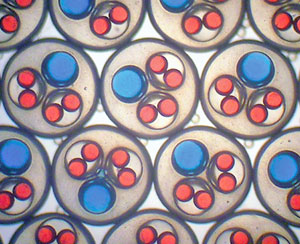This paper featured in Chemistry World describes a device developed by scientists in China that can control the production of multiple emulsion systems. The system could be used to encapsulate incompatible drug ingredients and to design multi-compartment materials, they say.

Optical micrographs of monodisperse sextuple-component triple emulsions, containing one water-in-oil single emulsion and two oil-in-water-in-oil double emulsions
Multiple emulsions are liquid systems in which emulsion droplets are placed inside each other, each droplet smaller than the last, creating ‘levels’. Microfluidic devices have been designed to produce such systems, but controlling the number, size and ratio of droplets at each level is difficult, especially when developing a system that has different types of emulsion droplets at the same level. Control over such multi-compartment levels would allow more precise encapsulation and the development of more advanced materials.
Liang-Yin Chu at Sichuan University and colleagues have designed a microfluidic device capable of producing multi-compartment multiple emulsions. Chu says: ‘We hope the novel type of emulsions in our work will open a new gate for the applications of emulsions in the fields of template synthesis, synergistic delivery, micro reactions, bioassay and so on.’
For the full story read Harriet Brewerton’s Chemistry World article or download the paper here:
Controllable microfluidic production of multicomponent multiple emulsions
Wei Wang, Rui Xie, Xiao-Jie Ju, Tao Luo, Li Liu, David A. Weitz and Liang-Yin Chu
Lab Chip, 2011, 11, 1587-1592
DOI: 10.1039/C1LC20065H










